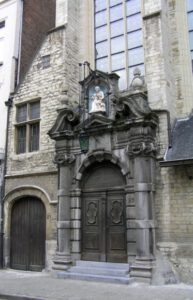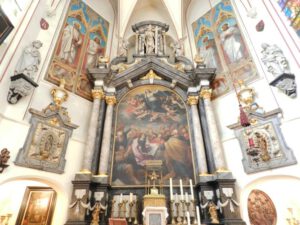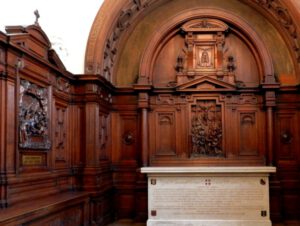Third NIGHT OF CHURCHES
Saturday 9 August 2014
1814 - 1914 - 2014
1814
After the French domination, the typical Antwerp Madonna and other religious images reappeared in the street scene.
1914
The ‘Great War’.
The Antwerp churches go in search of life in the parish in wartime, the parishioners who died and the priests in the resistance.
Come along on a journey to this living past.
12 churches in Antwerp went on tour
1514 – 1814 – 1914 – 2014
The chapel, originally of the dry shearers’ guild, was probably completed in 1514.
After the Concordat of 1801, it became a subsidiary church of the parishes of St. Charles and St. Anthony. Immediately in 1814, a statue of the seated Virgin Mary with Child was placed in the porch niche: a white-painted terracotta work by Joannes Eyckmans (signed and dated). The statue was just restored in 2014.
Early in the 20th century, the neighbouring building and subsequently the chapel too became the property of the Missionaries of Africa, better known as ‘the White Fathers‘ because of their exclusively white bar. They were only too happy to establish a missionary bureau in the port city, more specifically between the Central Station and the Scheldt quays where, among other things, the Congo boats moored. At the outbreak of the war the novices from Capenberg in Boechout fled to the study house in Boxtel, to be able to breathe “free Dutch air”.
On Christmas Day 1915 a total of 35 novices and young missionaries receive the message of their mobilization as stretcher bearers. Eight of them died on the battlefield. Brother Lode de Boninge, born in Antwerp from a French speaking notary family with the first name ‘Louis’, rebels at the front of the Ijzer at the sight of the needless misery of the Flemish soldiers and publishes for his soldiers, at his own expense, the paper De Leiekerels, but it is soon, just like all other Flemish associations, forbidden by the authorities. The clandestinity that follows ensures an even greater success of the (Flemish) Front Movement, which he later joins. However, he is killed in his service as a stretcher bearer. In 1934 his statue was inaugurated on one of the corners of the Ijzertoren in Diksmuide, but his father always refused to have his remains interred there in the crypt.
About 20 White Fathers in Congo are deployed as army chaplains in the campaign against German East Africa, being Ruanda-Urundi, half of them with the Belgian armed forces, the other as ‘chaplains’ with the British armed forces. They also did social work by mediating between the Congolese soldiers and their Belgian officers.
Neither the mission procura in Antwerp nor the chapel suffered any noteworthy damage. Their training centre in Boechout, on the edge of Antwerp’s defence perimeter, first receives hundreds of Belgian soldiers on the retreat, then masses of civilians, fleeing in panic at the news of unheard-of German atrocities, and also on their way to Antwerp. Afterwards, German soldiers are stationed there. During the war years, the trainee fathers turned out to be complete grain smugglers – thanks to their cassocks: “two bags of grain in the trousers, two bags in the cassock and two bags in the overcoat”. In those days, the religious habit had an inviolable value, for friend and foe alike…
 “They resisted the enemies of their country” is the biblical text from the Book of Maccabees (1 Maccabees 14:29) that pays tribute to the fallen. The crowning of the memorial shows the Belgian armour. The list of soldiers who gave their lives for their people is the start of an exhibition about the fallen parishioners with photos, letters and diaries.
“They resisted the enemies of their country” is the biblical text from the Book of Maccabees (1 Maccabees 14:29) that pays tribute to the fallen. The crowning of the memorial shows the Belgian armour. The list of soldiers who gave their lives for their people is the start of an exhibition about the fallen parishioners with photos, letters and diaries.
And don’t forget the beautiful statues of Mary in the neighbourhood, often named after the devotional statue in the parish church: Our Lady of Assistance and Victory: Pompstraat (1793) and Steenhouwersvest (1814).
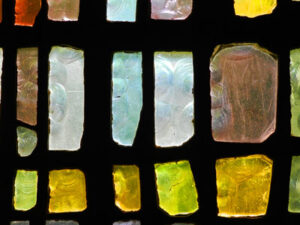 St Anne’s Church is too young to be able to tell much about WWI. Everything connected with earlier times is now buried. The 19th-century ‘St Anne in the pit’ church was demolished and replaced ‘at a higher level’ by the present modernist church built in 1970.
St Anne’s Church is too young to be able to tell much about WWI. Everything connected with earlier times is now buried. The 19th-century ‘St Anne in the pit’ church was demolished and replaced ‘at a higher level’ by the present modernist church built in 1970.
But for the ‘Night of the Churches’, Saint-Anna is opening its doors. It welcomes you to its double exhibition ‘MA‘, which stands for ‘openness, space in which people meet each other and the mystery’.
Japanese artist Sei Arimori lets the light do the talking and plays with reflections of the gold, symbol of life and spirituality.
In the work of the Belgian sculptor Annie Brasseur, tension and suppleness reign in the wood sculptures and pure geometry in the metal sculptures.
All this harmonises perfectly with the wonderful light and colour palette of the church-wide stained-glass windows.
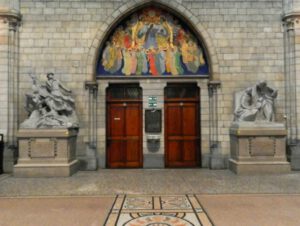 Two memorials form each other’s counterpart at the back of the church. Both white stone statues on marble pedestals are the work of the sculptor E. Deckers. The sculpture group ‘Anna, Joachim and Maria‘ was commissioned by anonymous donors in 1913. The ‘Monument to the fallen of the First World War‘ (1923), is a copy of part of the pedestal of his majestic equestrian statue of King Albert I, which now stands in Antwerp’s city park. The ever topical text on the pedestal, ‘Pray for those who through their deaths have left a lesson of willpower and strength not only to the young but to the whole nation‘, is based on the Bible book par excellence that deals with rebellion against the occupier (2 Macc. 6:31).
Two memorials form each other’s counterpart at the back of the church. Both white stone statues on marble pedestals are the work of the sculptor E. Deckers. The sculpture group ‘Anna, Joachim and Maria‘ was commissioned by anonymous donors in 1913. The ‘Monument to the fallen of the First World War‘ (1923), is a copy of part of the pedestal of his majestic equestrian statue of King Albert I, which now stands in Antwerp’s city park. The ever topical text on the pedestal, ‘Pray for those who through their deaths have left a lesson of willpower and strength not only to the young but to the whole nation‘, is based on the Bible book par excellence that deals with rebellion against the occupier (2 Macc. 6:31).
Yet the monument does not yet reveal its secrets. The question remains whether it was only erected in memory of the “Great War”.
Be sure to explore the numerous religious statues in the surrounding streets. The Paardenmarkt is home to, among others, a large Calvary group in the garden, a statue of Mary on the façade of the presbytery and, at n° 89, the statue ‘Our Lady with Child‘. And pay a visit to the Chapel of Our Lady of Good Success (left of the entrance).
‘De pastoor zwijgt niet’ (‘The priest won’t shut up‘) tells the story of pastor Bernaerts who was twice imprisoned by the Germans during the war. His courageous resistance against the occupier is illustrated with newspaper material from Groningen. You can also admire his painted portrait and the ciborium and paten that he received in gratitude from the parishioners.
A large list shows all names of parishioners who died or were involved in the war. We know the story of some of them. What secret the war memorial holds can only be revealed on the spot.
 The gable statues have their own story: the commemoration in 1914 of their reinstatement 100 years earlier, in 1814 after the French domination, was celebrated with … a penitential procession …. because of the war.
The gable statues have their own story: the commemoration in 1914 of their reinstatement 100 years earlier, in 1814 after the French domination, was celebrated with … a penitential procession …. because of the war.
 Although the beguinage church has no direct link with the “Great War”, you can enjoy the evening atmosphere in the church and the beguinage and drift away to beautiful organ music.
Although the beguinage church has no direct link with the “Great War”, you can enjoy the evening atmosphere in the church and the beguinage and drift away to beautiful organ music.
Be sure to discover the centuries-old statues in the beguinage, the statue of Saint Begga on the entrance gate and nearby the beautiful Madonna statues of the Ossenmarkt and Pieter van Hobokenstraat 26 (18th century).
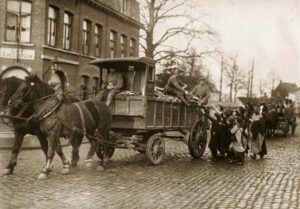 Come and enjoy an evocation of spiritual warfare songs to the music of well-known songs that were sung in our church during the “Great War”. They were specially published in book form at the time. A true discovery.
Come and enjoy an evocation of spiritual warfare songs to the music of well-known songs that were sung in our church during the “Great War”. They were specially published in book form at the time. A true discovery.
We will introduce you to the war events in Deurne, including the Zeppelins. Then we will sing a number of war songs to the accompaniment of the organ and … you may sing along.
Afterwards, we offer the visitors not only a snack, a recipe from a German war book from the “Great War”, but also a multi-coloured brochure with this and other “war recipes”.
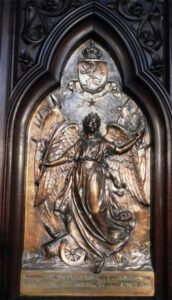 The memorial plaque erected for the fallen of the First World War bears the names of 25 parishioners who lost their lives in the “Great War” in copper. Already six months after the armistice, the initiative was taken to let them live on in memory. But did it succeed? What do we still know about them almost 100 years later?
The memorial plaque erected for the fallen of the First World War bears the names of 25 parishioners who lost their lives in the “Great War” in copper. Already six months after the armistice, the initiative was taken to let them live on in memory. But did it succeed? What do we still know about them almost 100 years later?
The 17th-century statue of Our Lady of 7 woes of The Brotherhood of the Faithful Souls has for hundreds of years appealed to mothers who come to pray for their sons-soldiers. A striking sword pierces Mary’s heart as predicted by Simeon at the commission of the 40-day-old Jesus in the temple (Lk. 2:35), a foreshadowing of Jesus’ suffering and death on the cross. This phrase remained current into the 17th century, as a sword was still part of the standard armoury. Less visible are the daggers, which represent the 7 ‘woe’s’ that determined Mary’s life.
On the central panel of the commemorative plaque, a great angel has descended to earth, Victoria, to announce the end of the war. Proudly she holds an attribute three times: a laurel wreath on her head, a large palm branch in her right hand and another laurel wreath in her left hand, while simply a cannon with a broken wheel alludes to the war that has brought death and destruction. The misery of war is summarily evoked in the background by a few crosses of war graves. Above the head of Victoria, a star shines, with above it the coat of arms of victorious Belgium with a clawing lion and the motto ‘Unity is strength‘. The panels to the left and right list the names of the war dead, to the left crowned with the coat of arms of Antwerp and to the right with St George overcoming the dragon.
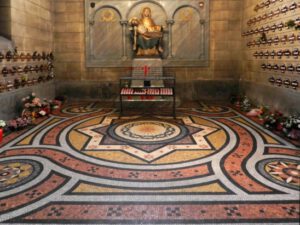 In October 1914, the neo-Romanesque tower was an excellent vantage point for monitoring the war in Antwerp. But the parish suffered during the war years. The war memorial that now forms the basis for a search for the fallen parishioners and their families reminds us of this. The ‘chapel of the fallen’ or ‘Pieta chapel’ is newly decorated for the occasion.
In October 1914, the neo-Romanesque tower was an excellent vantage point for monitoring the war in Antwerp. But the parish suffered during the war years. The war memorial that now forms the basis for a search for the fallen parishioners and their families reminds us of this. The ‘chapel of the fallen’ or ‘Pieta chapel’ is newly decorated for the occasion.
On 23 October 1921, Cardinal Mercier inaugurated the Pieta-chapel and unveiled the memorial stone in memory of the 72 parishioners who died during World War I. Their names are inscribed on a marble triptych. Although the church administration explicitly asked for the Belgian coat of arms to be added, architect Van Dijk continues to oppose this. In 1924 two coats of arms are placed in enamelled copper, with the coat of arms of the city of Antwerp and of the duchy of Brabant.
 The golden mosaic dome is studded with flaming stars. In the central motif, the inscription “DEXTERA DOMINI” points to the (right) hand of God holding the (gilded) cross of Jesus, to be understood as God’s blessing and assistance in the sacrifice of His Son Jesus on the cross, and at the same time to those who, following Christ, have allowed themselves to be sacrificed for “the peace of God”. At the edge of the dome the text clearly alludes to those who were prepared to carry Jesus’ cross, i.e. NISI IN CRUCE / DOMINI NOSTRI / JESU CHRISTI / ABSIT GLORIARI” (from the letter of Saint Paul to the Galatians (Gal: 6:14): “(God) forbid that I should glory in anything else but the cross of our Lord Jesus Christ”, (and the text continues in verse 16: “on all those who live according to this principle may peace and mercy come”).
The golden mosaic dome is studded with flaming stars. In the central motif, the inscription “DEXTERA DOMINI” points to the (right) hand of God holding the (gilded) cross of Jesus, to be understood as God’s blessing and assistance in the sacrifice of His Son Jesus on the cross, and at the same time to those who, following Christ, have allowed themselves to be sacrificed for “the peace of God”. At the edge of the dome the text clearly alludes to those who were prepared to carry Jesus’ cross, i.e. NISI IN CRUCE / DOMINI NOSTRI / JESU CHRISTI / ABSIT GLORIARI” (from the letter of Saint Paul to the Galatians (Gal: 6:14): “(God) forbid that I should glory in anything else but the cross of our Lord Jesus Christ”, (and the text continues in verse 16: “on all those who live according to this principle may peace and mercy come”).
Besides many other mourning family members, many a grieving mother still recognised herself many years after WWI in Mary, ‘the “Mother of Sorrows”, who laments her deceased child in this Pieta (polychromed sculpture by Petrus De Roeck, 1921).
The marble foundation of the monument also refers to hope in fearful days of war: “Do not grieve, ye Christians, as others who have no hope” (Thess. 4:12). On the golden band around the chapel, the (blood) red text from the Lamentations of Jeremiah not only urges spiritual consolation with Mary, but also compassion for the grieving families:
“O.MOURNERS.WHO.PASS.BY.THIS.WAY.
TAKE NOTE.AND.SEE.IF.THERE.IS.ANY.SMART.LESS.THAN.MY.SMART – Tren”. (A text from Lamentations, 1:12)
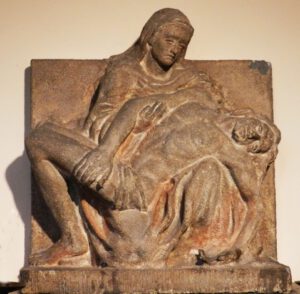 Following the celebration of the African community that starts at 7 p.m., this surprisingly open and bright church also houses the exhibition “The Great War versus The Little People”. You will not only get a picture of the war situation in the city and especially in the Volkstraat area, but also of the exodus of refugees from a besieged Antwerp.
Following the celebration of the African community that starts at 7 p.m., this surprisingly open and bright church also houses the exhibition “The Great War versus The Little People”. You will not only get a picture of the war situation in the city and especially in the Volkstraat area, but also of the exodus of refugees from a besieged Antwerp.
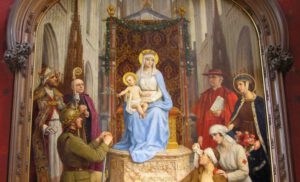 Just after the First World War, in 1920, the opening speeches of the Olympic Games in Antwerp were held in the main church. Cardinal Mercier, the bishop of Mechelen, alluded to the original Olympic idea of a competition as a remembrance of war. Somewhat later, one of the choir chapels was converted into the “Chapel of Our Lady of Peace” (1921-’24) as a memorial to the fallen. The new chapel is also artistically very important: it is the final piece of the 19th- and early 20th-century redecoration of the church in the neo-Gothic style and coincides with the extinction of neo-Gothic as an artistic movement in our regions.
Just after the First World War, in 1920, the opening speeches of the Olympic Games in Antwerp were held in the main church. Cardinal Mercier, the bishop of Mechelen, alluded to the original Olympic idea of a competition as a remembrance of war. Somewhat later, one of the choir chapels was converted into the “Chapel of Our Lady of Peace” (1921-’24) as a memorial to the fallen. The new chapel is also artistically very important: it is the final piece of the 19th- and early 20th-century redecoration of the church in the neo-Gothic style and coincides with the extinction of neo-Gothic as an artistic movement in our regions.
The altar painting by Jozef Janssens (1924) glorifies Mary in the cathedral as the Queen of Peace, united with, among others, the royal couple Albert I and Elisabeth, Cardinal Mercier, the parish priest and their patron saints. The striking predella paintings recall Antwerp amidst heavily ravaged cities, from east to west: Dinant, Leuven, Ypres and Nieuwpoort. Underneath are the names of 45 fallen parishioners.
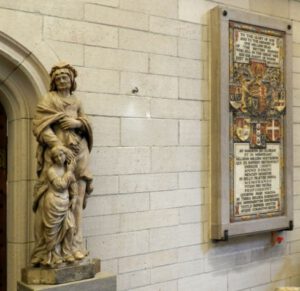 In the Chapel of Our Lady, the processions are highlighted, as well as the celebrations of 1864 and 1889 that commemorated the return of the statues of Mary in 1814. One of the two banners that were donated in 1864 to commemorate this event has just been cleaned and is now on display along with a number of attributes with which the statues were decorated on festive occasions.
In the Chapel of Our Lady, the processions are highlighted, as well as the celebrations of 1864 and 1889 that commemorated the return of the statues of Mary in 1814. One of the two banners that were donated in 1864 to commemorate this event has just been cleaned and is now on display along with a number of attributes with which the statues were decorated on festive occasions.
The statue of Mary ‘taken up to heaven’ at Groenplaats 28-29 (next to St.-Pieterstraat) was renewed in 1920 after the previous baroque terracotta one had fallen down: an age-related phenomenon, but it is not impossible that the bombardment of the nearby Beddenstraat in 1914 had a hand in this.

